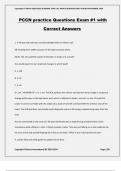Copyright © KAYLIN 2024/2025 ACADEMIC YEAR. ALL RIGHTS RESERVED FIRST PUBLISH NOVEMBER, 2024
PCCN practice Questions Exam #1 with
Correct Answers
1. A 49-year-old male was recently admitted with an inferior wall
MI resulting from 100% occlusion of the right coronary artery
(RCA). The 12-Lead ECG reveals ST elevation in leads II, Ill, and avF.
You would expect to see reciprocal changes in which leads?
A. I, aVR
B. V, V2
C. V, VA
D I, aVL - ANSWER✔✔-1. D. I, aVI. The RCA perfuses the inferior wall and the mirror image or reciprocal
change will be seen in the high latera wall, which is reflected in leads I, and aVL, on the 12-Lead ECG.
Leads V1 and V2 correlate with the septal area, leads V3 and V4 correlate With the anterior area of the
heart. The aVR lead does not provide much diagnostic value as all energy is depolarizing away from this
lead.
You are summoned to the room of a 30-year-old female who is experiencing sustained tonic-clonic
convulsions while sitting in a chair. A family member states: "She was just talking to us and suddenly she
let out a shriek and started flopping like a fish out of water." What is your initial priority of care?
A. Call for help and safely guide the patient to the floor
Copyright ©Stuvia International BV 2010-2024 Page 1/50
,Copyright © KAYLIN 2024/2025 ACADEMIC YEAR. ALL RIGHTS RESERVED FIRST PUBLISH NOVEMBER, 2024
B. Call for help and administer a prescribed antiepileptic
C. Call for help and administer a prescribed benzodiazepine
D. Call for help and monitor the course of the seizure - ANSWER✔✔-A. Call for help and safely guide the
patient to the floor
Patient Safety is priority
A 46-year-old patient presents with pneumonia and sepsis.
He was treated with 4 days of antibiotics and IV fluids. He is increasingly short of breath and is now on
100% FiO, via non-re-breather mask. You obtain an ABG with the following results: pH 7.20 / PaCO, 68/
PaO, 102/ HCO, 28. A chest x-ray reveals bilateral pulmonary infiltrates. The patient is likely developing:
A. Worsening pneumonia
B. Acute Respiratory Distress Syndrome
C. Pulmonary embolus
D. Atelectasis - ANSWER✔✔-B. Acute Respiratory Distress Syndrome
A 56-year-old male is admitted to the PCU with a hypertensive crisis. His blood pressure is now 205/125
mm Hg and he is complaining of a headache with nausea. He reports he ran out of blood pressure
medication three days ago, but also appears to be confused to the date and situation. What is the most
appropriate treatment approach?
A. Rapidly lower the systolic pressure to 100 mm Hg with IV antihypertensive medication, then gradually
reduce the diastolic pressure to 85 mm Hg with oral antihypertensive medications
Copyright ©Stuvia International BV 2010-2024 Page 2/50
,Copyright © KAYLIN 2024/2025 ACADEMIC YEAR. ALL RIGHTS RESERVED FIRST PUBLISH NOVEMBER, 2024
B. Slowly lower the systolic pressure to 120 mm Hg with IV antihypertensive medications, then switch to
oral antihypertensive medications for maintenance
C. Rapidly lower the diastolic pressure to 100 mm Hg with IV antihypertensive medications, then
continue to gradually reduce the diastolic pressure to 85 mm Hg with oral antihypertensive medications
D. Slowly lower the diastolic pressure to 85 mm - ANSWER✔✔-C. Rapidly lower the diastolic pressure to
100 mm Hg with IV antihypertensive medications, then continue to gradually reduce the diastolic
pressure to 85 mm Hg with oral antihypertensive medication
5. Which of the following labs must be closely monitored when administering Lisinopril to a patient with
systolic heart failure?
A. Sodium
B. Phosphate
C. Magnesium
D Potassium - ANSWER✔✔-D. Potassium
Patients taking angiotensin converting enzyme inhibitors may experience hyperkalemia. ACE inhibitors
block angiotensin II, which may lead to decreased aldosterone. Aldosterone is responsible forexcreting
potassium from the kidneys. Therefore, ACE inhibitors can cause potassium retension and potassium
levels should be monitored closely. In addition, renal labs such as BUN and creatinine should be
monitored. If the patient develops more than a 20% increase in the creatinine, the medication should be
discontinued.
Copyright ©Stuvia International BV 2010-2024 Page 3/50
, Copyright © KAYLIN 2024/2025 ACADEMIC YEAR. ALL RIGHTS RESERVED FIRST PUBLISH NOVEMBER, 2024
A 57-year-old man was admitted with an acute myocardial infarction and is rapidly deteriorating. He has
a BP of 86/42
(57), heart rate of 110, weak, thready pulses, and mottled skin-especially at the knees. He has had
minimal urine output the past 8 hours. A Rapid Response is activated. Which of the following
medications would be the best option to increase the patient's cardiac output?
A Dobutamine
B Norepinephrine
C Amiodarone
D Phenylephrine - ANSWER✔✔-A Dobutamine. Dobutamine is a positive inotropic medication used to
improve myocardial dysfunction on patients with a low cardiac index and elevated afterload. It will
improve contractility and reduce afterload. Milrinone, which is a phosphodiesterase inhibitor could also
be used as an alternative to dobutamine, in the setting of decompensated heart failure. It is used
cautiously in patients experiencing cardiogiogenic shock as one of the main side effects of Milrinone is
hypotension. The half life of Milrinone is about 6 hours. Norepinephrine and Phenylephrine cause
vasoconstriction, which would increase the SVR and may compromise cardiac output.
You are caring for a patient post gastric bypass. Which of the following parameters should you closely
monitor after surgery?
A* HR, RR, temperature, WBC & MAP
B* Protein levels and vitamin B12
C* Albumin and pre-albumin levels
D* Signs of dumping syndrome - ANSWER✔✔-A* HR, RR, temperature, WBC & MAP
Copyright ©Stuvia International BV 2010-2024 Page 4/50




